Soviet Body Armor in WWII.
I decided to create this page after several of my comrades raised interest
about steel chestplates worn by Red Army soldiers as mentioned in the article
about Siberian special-volunteers. A friend of mine Pavel provided with me with
a link to an awesome article on the topic, which I have translated below. I
have also summarized some random data to provide necessary background as well.
It is also worth noting that until very recently all information about the use
of steel chestplates was classified.
WWI was the beginning of the modern combat era, and a lot of innovations have
their roots in that global conflict. Both the helmet and personal body armor
were invented during WW1. The initial motivation was to protect soldiers from
rifle bullets, but pretty soon the realities of combat compelled armies to take
a more fundamental statistical approach to the subject.
I summarize below the main conclusions drawn from the Wound Ballistics study
conducted by the Medical Department of US Army in WWII and Korean War.
Source.
Causative Agents. Based on a study of 1,000 American KIA in Italy during WWII.
In the descending order of distribution:
1). High Explosive (shockwave and shrapnel) - the most common cause of death,
usually killed less than 10m from the explosion.
2). Shell Fragments (shrapnel) - shockwave effects are negligible.
3). Small Arms (bullets) - about 10% of total casualties, usually killed from
less than 200m range.
Thus, most of the casualties in WWII were caused by both shockwave and fragmentation
effects of explosions and not by bullets. Realizing this helps to understand
the value of helmets and body armor.
The helmet, for example, is not highly effective against rifle bullets, but
considering that shrapnel is the primary source of head and neck injury, it
offers a great trade-off between its value and the inconvenience associated
with wearing it.
Similarly, to achieve optimum trade-off, body armor was designed to provide
protection primarily against shockwave and fragments. A great variety of experimental
body armor was created in WWII - ranging from medieval type plated armor to
scale composite armor. Only with the advent of light-weight metallic and nonmetallic
ballistic material, though, did the composite steel/aluminum and nylon/doron
vests gain popularity.
In WWII, though, such technology was still at its infancy and in the Soviet
Union more attention was given to steel chestplates for individual protection.
I quote below from an article by M. Svirin, a writer for Tankomaster and other
Russian journals.
There were four kinds of cuirasses worn by Red Army soldiers in WW2. The most
common types were riveted and welded with a ribber under the neck. The first
were, apparently, made before the war, and younger soldiers avoided using them.
Some soldiers still preferred the riveted cuirass for their light weight and
similar protection level.
Sometimes, soldiers wore chestplates only without the groin cover. A common
practice was to wear armor over quilted jackets. Such jackets lessened the shockwave
from explosions, especially of the German Stielgranate, whose shrapnel could
not penetrate the armor, thus saving soldiers from internal injury.
Some soldiers who wore chestplates only also liked to tie their entrenching
tools to their waists for more protection.
German submachine guns were not very popular for their unreliability, while
among domestic weapons the most popular were PPSh with clip magazines. Above
all the SVT semi-automatic rifles were preferred for their accuracy, a wooden
butt and a bayonet.
Molotovs were used to flush out the enemy or to render rooms uninhabitable for
at least some period of time.
Demolition experts usually used powerful anti-tank mines with simple or electric
fuses.
Source.
The chestplate produced in WWII was SN-42, here are its specifications:
SN-42 - Stalnoy Nagrudnik 42 - Steel Chestplate 42.
Weight: 3kg
Thickness: 2mm
Reportedly it could stop 9mm rounds fired from MP-40 at 125-150m.
Source.
I have also found some photos of Soviet body armor on a militaria website.
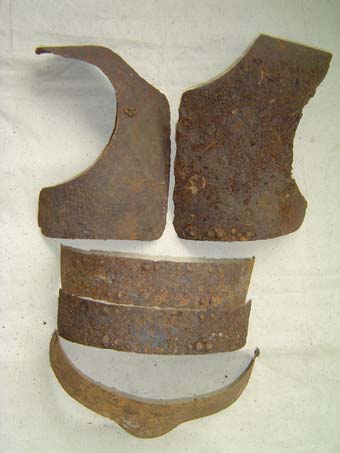
WWI type body armor. Front. Found near Volkhov.
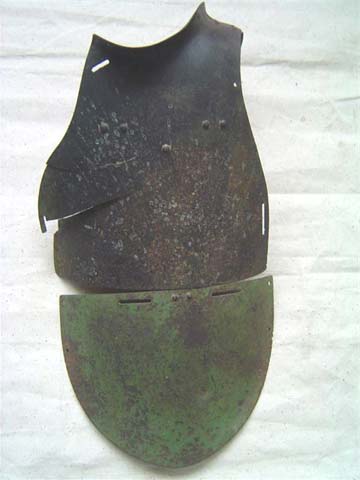
SN-42, WWII type body armor. Front. Found near Pitomnik, Stalingrad.

The chestplate. Back. Note the holes for wearing and the hinges for special lining.
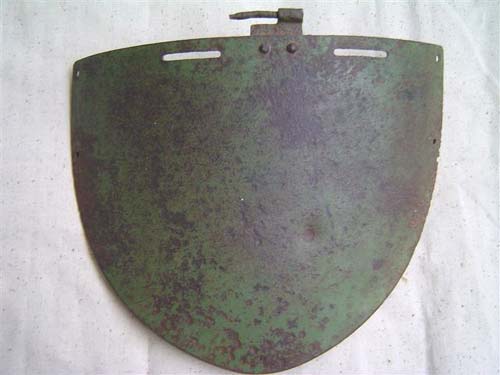
The groin protector from the above set. Front. Note the dent, probably caused by a pistol bullet.
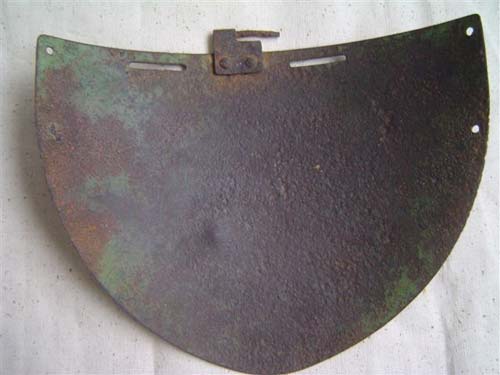
The same piece. Back. Note the dent.
Even a brief introduction to the topic would not be complete without at least
some data on the secondary adversary of body armor - bullets.
German machine gun penetration:
MG 34/42, 7.92x57mm SmK
100 at 0deg --13mm (Jentz)
100 at 30deg --8mm (Fleischer 1994)
500 at 0deg ---8mm (Jentz)
500 at 30deg --3mm (Chamberlain 1978)
Source.
Unfortunately, I do not know whether this data is specifically for long bursts
or single rounds, but my guess would be the latter - therefore, same ammo should
have almost same characteristics when fired from regular bolt-action rifles.
Either way, it is plainly obvious that SN-42 could not defeat
rifle bullets, unless they ricocheted.
German Parabellum pistol ammo data.
The PPO8 m.E. (mit Eisenkern, with iron core) replaced the standard PPO8 in
1943 and had a steel case, steel-jacketed bullet with mild steel core, and copper-plated
jacket inside and out. The bullet weighed only 98 grains as compared with the
standard’s 124. There was also a 9 mm. sintered iron bullet, PPO8SE.
Source.
German MP-40 submachinegun penetration data (assuming PPO8 ammo):
dry pinewood 23cm at 50m, 15cm at 200m;
brick wall 4cm at 50m;
sheet metal 2mm at 50m;
steel armor of 2mm will only be dented.
Source.
Modern Tokarev (PPSh) pistol penetration data and not only.
Testing confirmed that in most instances the lighter Hollow Point (HP) projectiles
(.380, 9mm, .40 cal.) open prematurely or do not open at all, the HP cup filling
with target medium, turning itself into lighter ball ammo, or the HP projectile
takes a different path from the flight path upon entering the target medium,
resulting in non lethal hits or lesser wounds than intended due to deflection
of the projectile from the unstable HP cup reacting to hydrostatic pressure
from impact with the target medium (veering off course, so to speak)
In defeating armor, the lighter, less than common 7.62x25 Tokarev in it's high
velocity variant (Czech round for the vz52 at 1700fps) can penetrate earlier
versions of body armor, but newer level IIA will stop it. In the unprotected
body, it tends to penetrate on a straight line, as did the old .357 pointed
ball, sold in the 50's through the 80's, but does less damage along it's path
than the heavier bullets.
Source.
Here
is also some more data on modern bulletproof vests.
Finally, I am inclined to believe that SN-42 accomplished well what it was
designed for - defeat shrapnel and pistol bullets, as well as to protect soldiers
in hand-to-hand combat.
Having completed this brief introduction, I finally present the translated article
below.
Assault-Engineer Units of Stavka Reserve.
I. Moschansky
M-Hobby, #4 1999.
Source.
Translated by R.F. Mikael.
By spring 1943 the strategic initiative on the Soviet-German front was shifting
to the Red Army. Even the retreat of our forces from Kharkov in early 1943 did
not shake Stavka’s confidence in the turn of the tide. The Soviet infantry,
however, while not lacking in personal valour, was behind the German counterpart
in terms of training and equipment. Despite being quick learners, our level
of technical tradition was lower which did not allow to quickly create units
equal to German ones. Therefore, the Soviet command made up for this by producing
higher quantities of war materiel (guns, tanks, planes) leading to a production
race that Germany did not win. But also we created highly trained and skilled
assault infantry units, which presented both a quantitative and a qualitative
superiority over the enemy at the critical sectors of the frontline.
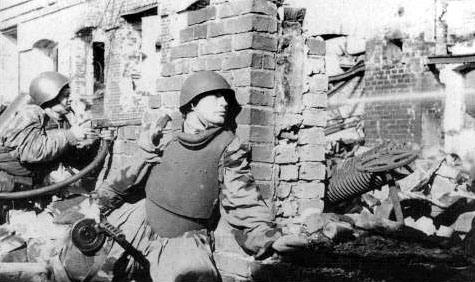
Assault of soldiers from 1.ShISBr
Central Front, September 1943
The special units were decided to be created on the basis of existing engineer-sapper
units, which possessed necessary technical knowledge and high cohesion in action
under enemy fire. The officers in these units were more proficient generally
and tactically, above all they valued the lives of their specialist-soldiers.
By May 30th 1943 Stavka ordered to form the first Assault Engineer-Sapper Brigades
(ShISBr), which was done by remaking the existing units into assault ones. This
way the first 15 brigades were formed.
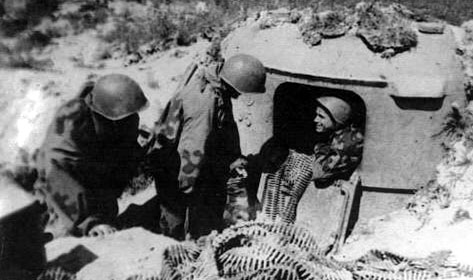
Enemy Strongpoint Captured!
1.ShiSBr, Central Front, September 1943
Assault Engineer-Sapper Brigades of Stavka Reserve were intended to break through
the enemy’s powerful fortified lines of defense. Each such unit had headquarters,
engineer reconnaissance and signal companies, five assault engineer-sapper battalions,
a company of trained sapper-dogs and a light ferry train.
Considering the new missions, the personnel had to be significantly renewed
- all the soldiers above 40 years old and the ones with limited capabilities
were reassigned to other units.
Weaponry and equipment had also significantly changed: every soldier had a submachine
gun (initially PPSh, later PPS) and a Finnish knife. The battalions were also
lavishly supplied by sniper rifles, anti-tank rifles and light machine guns
(DP), not counting various grenades: anti-tank (RPG-43), anti-personnel (F-1,
RPD-33) and molotovs used to destroy defensive constructions. The training was
organized appropriately: most time was spent on hand-to-hand combat and throwing
of grenades. The soldiers were also taught to pass over walls, wire and wooden
obstacles, and to fight with the entrenching tool. For that purpose the commanders
taught how to use sharpened sapper spades.
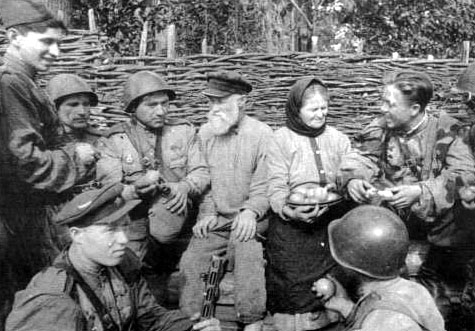
Sen.Lt. Bozhinsky's sappers in village Palkin in Konotop region.
1.ShiSBr, Central Front, September 1943
M. Tzun, the captain of the 62nd Storm Battalion of the 13.ShISBr used combat
ammunition on the obstacle course promising “to shoot the rear off”
any soldier who was not crawling low enough. Despite holding the machine gun
relatively high, according to the witnesses, “the soldiers crawled like
only the instructors do during shows for high commanders.”
Other equipment included a standard issue helmet and a steel chestplate, capable
of defeating bullets and small shrapnel. This piece of armor was usually worn
over sleeveless quilted jackets which served as additional cushion, even though
the chestplate had its own special lining. Sometimes the chestplates were also
worn above camouflage coats and above raincoats as well.
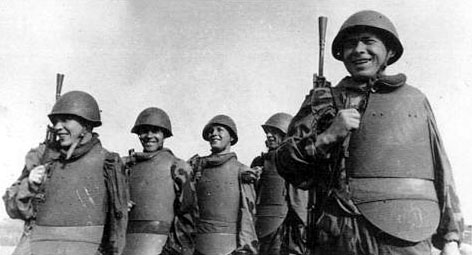
Guards Assault Infantry returning from a mission.
1.ShiSBr, 1st Belorussian Front, Summer 1944
The soldiers themselves had mixed feelings about these chestplates - some cherished
and some absolutely hated them. Analyzing the combat history of these specialized
units, the following paradox emerges: the chestplates were regarded high in
the units which captured large cities, while the negative attitudes came mainly
from the units that captured field fortifications. The chestplates protected
from bullets and shrapnel while the soldiers walked or ran, and also in hand-to-hand
combat, thus, it was most useful in urban fighting. In the field, however, the
assault engineers crawled most of the time and then the chestplate was an unnecessary
hindrance. In the units that fought in rarely populated areas these chestplates
traveled first to battalion and then to brigade depots.
Already in August 1943 a few express-trained ShISBr’s arrived to the front.
1.ShISBr fought its first battle in the region of Spas-Demensk (Western Front)
on August 10th, 1943.
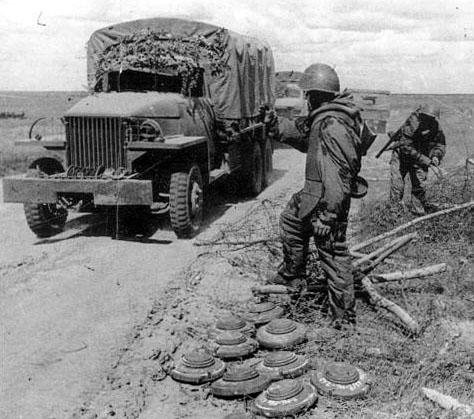
"Checked, No Mines! Note Studebaker trucks.
1st Belorussian Front, Summer 1944
After the Battle for Kursk the Germans went over a strategic defensive all along
the frontline, and the arrival of such assault units was timely. Especially
since precisely at the Western Front the static positional warfare already lasted
one and a half years.
After unsuccessful attempts of our infantry from the 10.Guards.Army with air
and artillery support to capture the Hill 233,3, the Soviet command assigned
this task to special units which possessed the necessary training and equipment
to overcome enemy defenses.
On August 10th, the 1.Storm.Bn together with the training company of 5.Storm.Bn
with artillery support was ordered to assault the Hill 233,3, push the enemy
back, secure the hill and defend it until the arrival of regular units.

Guards Sen.Sgt. Bogotnikov, awarded the Red Star order and the Medal of Valour.
1st Belorussian Front, Summer 1944
The top of the hill was surrounded by an anti-tank ditch up to 900m long, all
the approaches to the hill were mined and surrounded by two lines of barbed
wire. The defense system had carefully hidden remote-controlled mines and also
a good alarm system. The strongpoints were covered by all-metal hoods brought
from Germany which allowed all-around obversation and machine gun fire.
The height was defended by Waffen SS troops. There were barracks, supply depots,
repair shops, a bath and even a lounge underground. The garrison of this underground
town numbered 800 soldiers and officers... Before the assault Major Belokon
walked among his soldiers assembled on a clearing in the woods.
– We are given a difficult task: to take the height, which the enemy considers
impregnable. We are given a chance to accomplish a heroic deed, of which each
of us dreamed. Let’s raise this flag on that height.
The Major unfolded the banner, and the sun shined over the red cloth. The wind
smoothed out the flag.
– Shall we take the height? Will we not bend? - loudly asked the Major.
The commander of the 1.Storm.Bn decided to capture the height by a sudden bold
assault. He refused the artillery barrage, which served as a warning of an imminent
attack, and asked the artillerymen to open fire at the sappers’ signal.
The assault was planned to begin soon after dusk on August 10th, 1943. The Germans
usually had supper at this time. Belokon knew this and chose this time to surprise
the hitlerites.

Private Vataman, using a faustpatrone beat 10 hitlerites to death.
Every soldier carefully studied the directions of the advance and knew his own
task well. The assault specialists were armed with grenades, submachine guns,
Finnish knifes, and everybody wore his chestplate for protection against bullets
and shrapnel.
After coming 150m close to the enemy positions, several Katyusha salvos were
requested and then immediately four companies attacked the WSS soldiers from
all sides, while artillery bombarded the depth of the defenses in order to pin
down the reserves. The engineer-sappers reached the enemy trenches and engaged
the enemy in hand-to-hand combat.
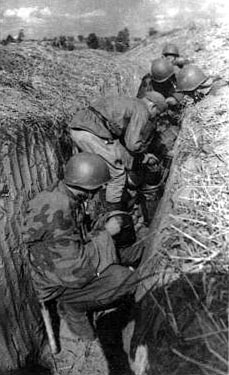
Dinner time.
2nd Belorussian Front, September 1944
Running in front of his comrades, Senior Sergeant Lazarev headed towards a bunker.
A fascist officer rose in front of him and unloaded his pistol’s magazine
point blank into sergeants chest, but the bullets did not stop him. Lazarev
hit the officer on the head with the butt of his submachine gun. After reloading
his PPSh, he entered the bunker and eliminated several more fascists, who were
shocked from what they saw: an officer shot point blank into a Russian, but
he remained unhurt.
In that battle several similar incidents took place. Already after the operation
the prisoners repeatedly asked to explain the “invincibility” of
the Russian infantry. They were shown the chestplate. Created by the storm groups
in WW1, this chestplate was just as effective under similar circumstances 25
years later.
The height was assaulted from three converging directions. Wherever the fascists
ran, they were hit by frontal and flanking fire of our troops.
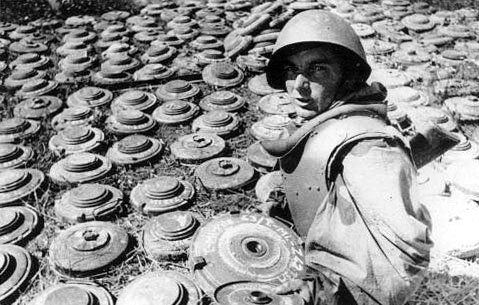
Jnr.Sgt. Chervonyak near the mine stockpile captured from the Germans.
1944
The battle lasted two hours. Almost all of the hill was captured by Belokon’s
soldiers, who with a group of soldiers walked to the top and raised there the
red flag.
An imprisoned Senior Corporal Rudolf Schweige told the interrogators that the
fascist command considered the Hill 233,3 impregnable, and that it only fell
under the pressure of some new strange Russian infantry, which acted decisively,
courageously and boldly without any tanks and after only a short artillery bombardment.
The Western Front’s Military Council greatly appreciated the accomplishments
of the komsomol men of the brigade awarding 91 of them with orders and medals.
The battalion commander Major Belokon was awarded the order of Alexander Nevsky.
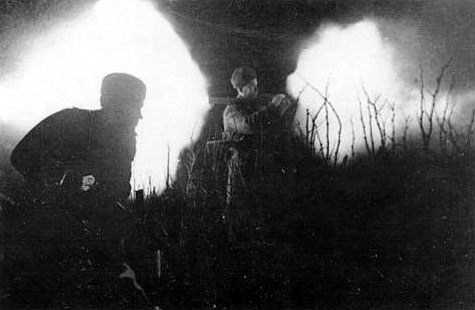
Snr.Sgt. Kireev fires a faustpatrone during night combat.
Breslau, 1st Ukrainian Front, March 1945.
However, when cooperating with other kinds of forces, especially rifle units,
the battles were not so successful.
The experience of ShISBr showed that quite frequently these units were inappropriately
used. Instead of assaulting heavily fortified positions in groups and squads,
these brigades were used as simple rifle formations being assigned their own
sectors of advance. Because such brigades lacked heavy weaponry and artillery,
they suffered heavy losses. It also happened that ShISBr accomplished other
tasks not in any way connected to attacking.
Only in December 1943 the guidelines for the use of such formations were clearly
formulated. The brigades were to provide engineer support in breaking through
heavily fortified positions in the tactical defense zones of the enemy. After
accomplishing their tasks, the brigades were to immediately pull back into reserve
for reinforcement and retraining. They were also allowed to be used to clear
mines, reconstruct roads and bridges. Combat experience showed that ShISBr succeeded
when efficiently cooperating with regular rifle units, artillery and tanks.
Shortcomings in the use of ShISBr were eventually eliminated. These brigades
(20 in the beginning of 1944) were subordinated to Stravka Reserve and, therefore,
used at the critical sectors contributing greatly to the success of offensive
operations.
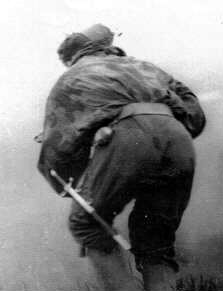
This fighter is armed with a dirk.
1st Belorussian Front, April 1944
In the spring 1944 the ShISBr were reinforced with batallions of ROKS-3 knapsack
flamethrowers. At the same time 5 new motorized SESBr (2 and 22 Guards, 20,
21, 23 MShISBr) were formed, which, although smaller, were much more mobile.
The 1, 2, 4, 10, and 2 Guards ShISBr were assigned armored-engineer regiments
with PT-3 mineroller tanks (T-34/76 and T-34/85), as well as 20 TO-34 flamethrower
tanks in three companies.
Sometimes ShISBr also received special-purpose battalions (OBON) with American
amphibious vehicles Ford GPA and DUKW.
In June 1944 the 1.ShISBr (full name - Komsomol.Smolensk.Redbanner.Suvorov.Kutuzov)
consisted of 5 storm batallions, 510.FtTank.Rgt, 40.EngTank.Rgt, as well as
the 36.Ft.Bn.
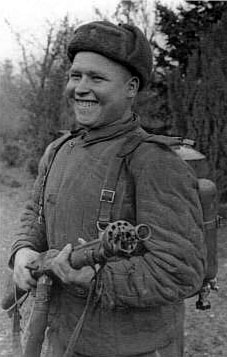
Communist flamethrower Grechishnikov destroyed 30 hitlerites.
Breslau, April 1945.
Since the end of 1944 the German army received en masse highly effective infantry
anti-tank weapons: “Faustpatrone” and “Panzerschreck.”
These weapons did not pass unnoticed by the Red Army. Captured “faustpatronen”
were to be collected and sent to the frontal engineer units, which then used
them accordingly. Most of the “faustpatronen” went to ShISBr, whose
storm groups used them to suppress enemy strongpoints.
During the battle for Danzig in March 1945 the 1.ShISBr created 30 storm groups.
Each group had 4 assault specialists and 4 flamethrowers (2 of which were in
reserve). Each such group was supported by a “faust” team of 4 sappers
(commander and three soldiers which also carried a special device to launch
a salvo of rockets). That special device was our invention and allowed 10 rockets
to be launched simultaneously. The “faust” team was armed with 50-80
rockets and 12 machine gun disks. For transportation and support each storm
group had one tank or a self-propelled gun. For the assaults against especially
difficult targets the group was assigned miners as well. Each miner section
was given 200kg of explosives. By 1945 our assault-engineers reached a high
level of professionalism. Using sewer hatches as reflectors large shaped charges
were made to blast holes in the walls which then were targeted by flamethrowers.
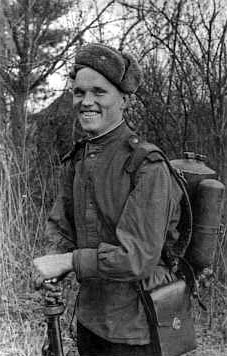
Flamethrower on his way to an enemy stronhold. Note the bag with a heat-resistant mask - a distinguishing feature of a flamethrower.
Breslau, April 1945.
Heavy fighting took place on Breit Gasse street. Lieutenant M.M. Danilov’s
company arrived here first. The soldiers were in a difficult situation immediately.
The enemy pinned them down with heavy fire. Although our artillery guns were
firing directly over open sights, the assault engineers could not reach the
strongpoint. Then two hotshots, Junior Sergeant P.A. Semenov and Private Artemev
moved forward. Hiding behind a corner, they located enemy machine guns and hit
them with faustpatrones. Three loud explosions shook the air. Three machine
guns ceased to exist. The whole building was covered in smoke, dust and flame.
The other soldiers of the storm group acted immediately. They quickly surrounded
the building. The surviving hitlerites in panic jumped to the street, but they
could not reach friendly lines. A total of 18 fascists were taken prisoner.
Taking cover behind nearby buildings, sappers armed with faustpatrones reached
enemy strongpoints and fired at the windows where the machine guns were deployed.
Meanwhile, the others threw grenades into windows and doors, where the fascists
were fighting from. If enemy resistance did not stop, then the walls were blown
by one or two shaped charges. Usually, the enemy garrison surrendered soon afterwards.
But if the resistance continued, then the holes in the walls were bombarded
by grenades. The outcome was then decided in a hand-to-hand battle. During the
first two days of the assault on the city the enemy resistance was destroyed
in such a manner in 19 buildings.
During the combat inside quarters the importance of faustpatrones and flamethrowers
only increased because under such conditions support of artillery and tanks
was virtually impossible. When the assault engineers managed to reach within
the flamethrower range of an enemy strongpoint, the success of the assault was
pretty much assured because the fire forced the enemy to abandon that position.
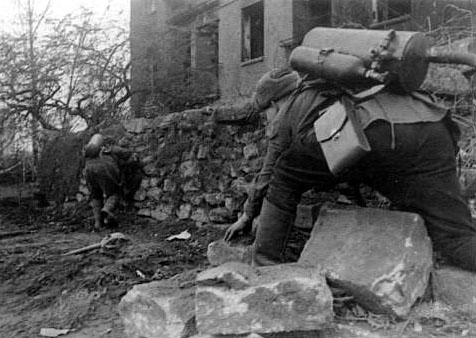
Note the same case for a fireproof mask.
Once the flamethrowers were used to set buildings on fire in order to make them
inaccessible to the enemy.
Overall, during the assault on Danzig the sappers used faustpatrones skillfully
and effectively. Almost daily the assault engineers fired 200-250 faustpatrones
at the enemy. Even though the shots from faustpatrones were not always accurate,
the force of the explosion allowed to eliminate enemy strongpoints inside buildings
from two-three shots.
Storm engineer brigades took part in the battles for almost all major German,
Polish and Hungarian cities.
After the end of the Great Patriotic War, four ShISBr were redeployed to the
Far East, where they stormed the fortified regions of the Japanese Kwantung
army.
The 9.ShISBr was attached to 39.Army, 5.ShISBr to 6.Guards.Tank.Army of Zabaikal
Front, 20.ShISBr to 1.Far East Front, 21.ShISBr to 15.Army of 2.Far East Front.
The assault sappers fought since the very beginning of major operations. The
enemy resistance was especially stubborn in the Khailarsk fortified region.
The assault commenced after all neccessary study and preparation. Under the cover
of the support group, which usually occupied all the approaches to the strongpoint,
the sappers reached the fortifications and destroyed them with shaped charges.
Machine gun nests were usually blocked by tanks to allow the sappers reach the
enemy lines. If this was not possible, then the sappers took advantage of the
terrain or trenches and blocked the enemy with armored shields or sandbags. Then
the doors on the strongpoints were blown by shaped charges fixed at the ends of
long poles. In especially large strongpoints the enemy garrison hid in underground
casemates. The garrisons were eliminated by explosives thrown into the ventilation
shafts. Altogether in the Khailar fortified region the sappers destroyed 50 strongpoints
and 8 other fortifications. The engineer forces of the Zabaikal Front destroyed
755 fortifications, of which 301 strongpoints, while liquidating enemy resistance
in the borderguard fortified region.
Heavy fighting raged at the other fronts of the war as well. Facing fanatical
Japanese troops, who continued fighting and hiding in the shelters, the sappers
started using new assault means - the enemy fortifications were flooded with
benzine or kerosene.
In such a manner, on the Lesnaya mountain (35.Army’s sector) 600 liters
of kerosene was poured into the ventilation shafts of a major strongpoint, at
the Ostraya mountain - up to 2 metric tons of benzine. The Japanese refused
to surrender and were destroyed, they lost up to 800 men in the strongpoints
mentioned above.
After the war was over most of the ShISBr were disbanded.




















